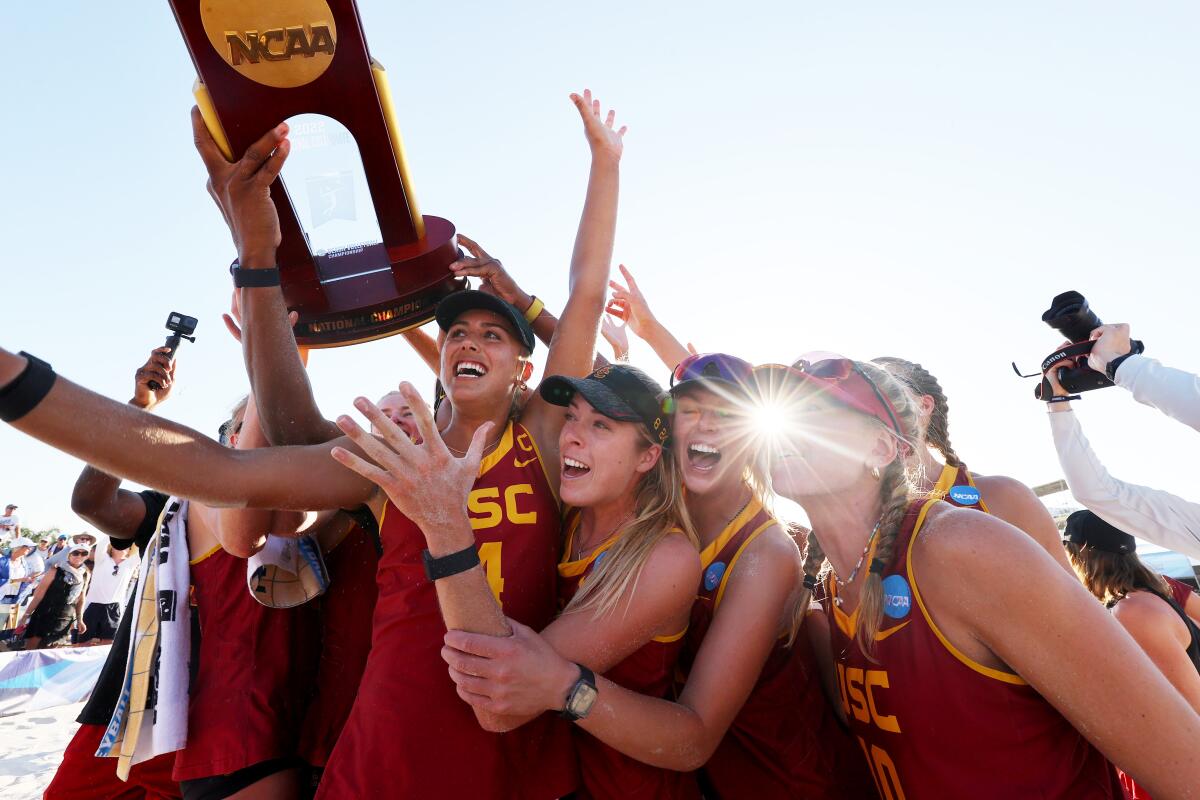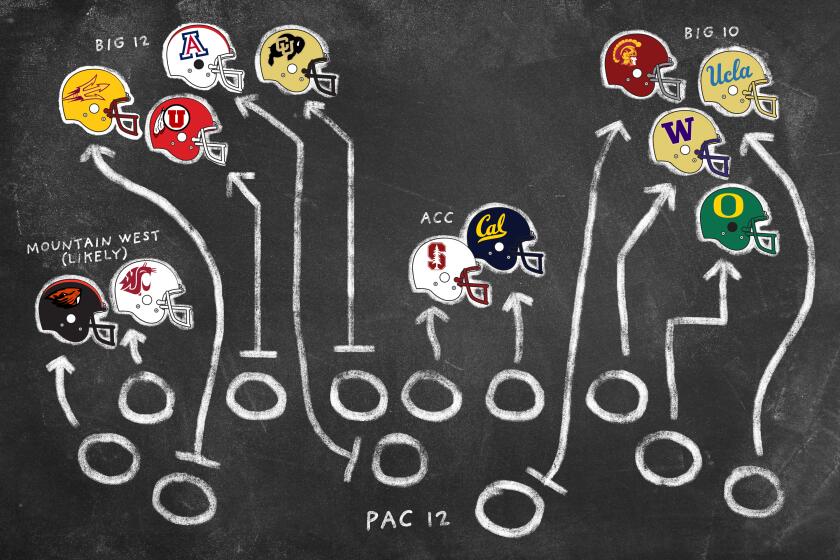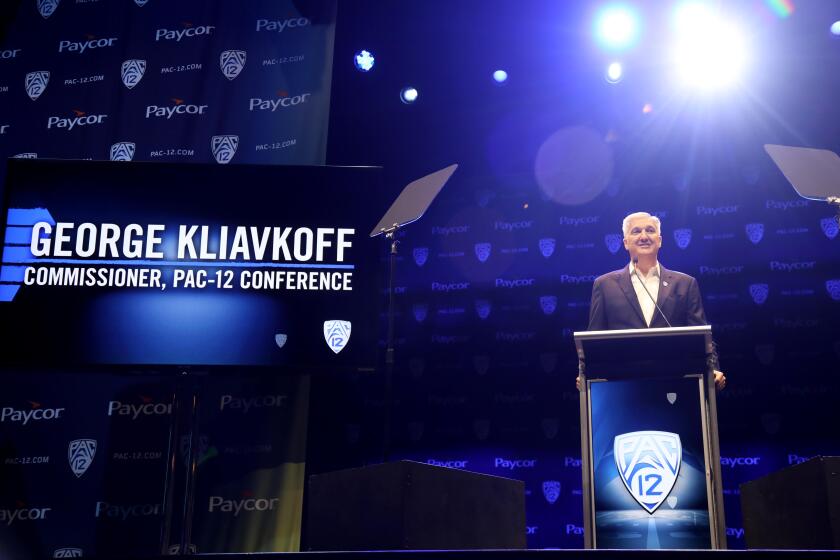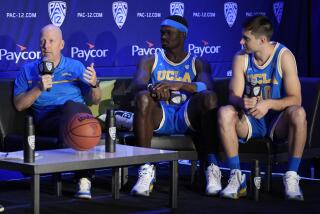Opinion: The Pac-12 is the ‘Conference of Champions.’ Don’t let it disappear

- Share via
No collegiate athletic conference has been more dominant than the Pac-12 when it comes to winning national trophies. As of this month, the conference has earned an unmatched 553 NCAA championships, with a 200-plus trophy cushion over the second-place league.
And this legacy of success doesn’t belong just to the powerhouse sport of football.
Consider the Olympic sports contested across the NCAA: Pac-12 schools dominate the top 25 national rankings and finishes, and Stanford, UCLA and USC sweep the podium spots for schools with the most NCAA team titles. If the Pac-12 were a nation, it would have placed fifth in the medal count at the pandemic-delayed Tokyo Games in 2021 and the 2016 Rio de Janeiro Games. Indeed, it is Olympic sports that have made the Pac-12 the “Conference of Champions.”
The money-driven implosion of the Pac-12 has shown how toothless the NCAA has become in supporting ‘student athletes’ and fans. It’s all about the money.
One would think that with stats like these, the college presidents and university athletic directors in the Pac-12 wouldn’t let the conference disintegrate, picked apart by its fellow leagues and set to disappear at the end of the school year.
But thinking that way denies the central existence of football in the business of college sports (and higher education for that matter), as well as the century-plus history of football policy driving all college sports policy.
Right now, higher education’s football industry is being dragged into a new business model, pretty much against its will. Federal courts are listening to athletes’ antitrust challenges to the NCAA, and the National Labor Relations Board is considering their right to organize and bargain collectively.
The cause of death was massive hemorrhaging, with 10 schools announcing plans to depart the conference in 2024.
In response, the top football schools aren’t reinventing their programs as you might think they would; they’re just trying to figure out how to keep cashing in: breaking agreements, backstabbing one another (and their athletes) and switching league allegiances in pursuit of media dollars and an expanded (and therefore more lucrative) 12-team College Football Playoff.
And they’re dragging the rest of the sports on their campuses along with them into new coast-to-coast megaconferences.
Just one year after UCLA and USC announced they would be deserting the Pac-12 to join the Big Ten Conference (creating a four-time-zone behemoth), most of the rest of the dominoes have fallen. Only Washington State and Oregon State remain in what is now in effect a Pac-2. Colorado, Utah and Arizona, along with Arizona State (where I competed in track and field when I was a PhD student and where I now teach) joined what will be a 16-member Big XII. Oregon and Washington bolted to become the 17th and 18th member schools of the Big Ten, and, finally, Cal and Stanford, whose campuses are not far from the Pacific Ocean, announced they would join the Atlantic Coast Conference.
This fall marks the start of a farewell tour for many of California’s sports rivalries. We explain how the conference arrived at this moment and what it means for athletes and fans.
When I competed for ASU, Stanford was our big distance-running rival; now Stanford will be conference foes with my undergraduate alma mater, the University of North Carolina, on the opposite coast.
It’s trippy, and it will be devastating for many of the non-football athletes at Pac-12 schools. When they have to travel to far-flung meets and games they probably won’t fly charter, like revenue-producing football players. They may find themselves on long bus rides or juggling layovers and connections, and spending more time away from campus than if they were primarily competing regionally.
Especially for students who compete in softball, baseball, volleyball, basketball, soccer and other sports with regular season competition and multiple games per week, participation in megaconferences spread across the country will cause serious travel-induced harm.
How did the Pac-12 die? These surprising decisions by USC, Oregon, Washington and others thwarted efforts to save the conference.
Athletes will miss more classes, and more of non-academic college life. They will be more sleep-deprived, and more likely to get sick or injured or to experience anxiety and stress as they struggle to balance their academic and athletic obligations.
The schools, which already spend a lot of money to help athletes succeed at managing their roles and responsibilities, will need to throw even more resources at the problem. The cost of doing business, so to speak, already precariously high, will tick up. If there’s a budget shortfall, the megaconference schools may decide to tackle it by cutting “niche” sports from their programs completely.
None of the above has to happen.
Instead of dragging all sports into the megaconferences (and letting TV networks dictate how schools structure athletics), the Pac-12 athletic departments should be organized sport by sport, with those that want to continue conference play within the western regional league free to do so.
There already is precedent for a sport-by-sport model at many of the schools in the Pac-12. Water polo does not play in the Pac-12, but in the Mountain Pacific Sports Federation. The same was the case for Pac-12 women’s lacrosse teams until enough of the conference’s schools added the sport to their rosters.
Is the Pac-12 really so diminished it can’t land a TV deal? A closer look at why the league is struggling ahead of the USC and UCLA’s departure.
And why shouldn’t the nine Pac-12 beach volleyball teams keep playing in their best-in-class league (they’ve won every NCAA title since championships commenced in 2016)? The megaconferences the Pac-12 schools are joining barely even have beach volleyball programs.
For a host of reasons, keeping the Pac-12 umbrella, with its brand of excellence and western regional focus, makes sense. The switch to sport-by-sport organization, which will mean more individualized decision making overall, should also better serve the needs of college athletes.
The Pac-12, over more than a century, has compounded its advantages — excellent academics, high-level interconference competition, campuses located where training can often go on year-round — and become the world’s premier league for sports that aren’t football. None of that needs to be sacrificed, along with scores of college athletes, to the messy upheaval that’s revolutionizing the college football industry.
Stop writing the obits for the Conference of Champions. Sport by sport, let the Pac-12 live.
Victoria Jackson is a Pac-10 and NCAA champion and retired professional runner. She is a clinical associate professor of history at Arizona State University.
More to Read
A cure for the common opinion
Get thought-provoking perspectives with our weekly newsletter.
You may occasionally receive promotional content from the Los Angeles Times.














